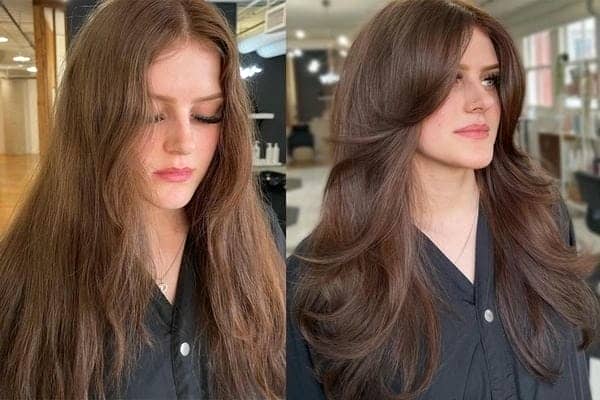
Discovering the perfect haircut when you have thin or fine hair can feel like a challenge, but it’s far from impossible. The right style can dramatically change the appearance of your hair, creating the illusion of fullness, texture, and volume. It's all about strategic cuts, clever layering, and understanding how different lengths interact with your hair type. Finding the ideal look is key to boosting confidence and simplifying your daily styling routine.
Understanding Thin vs. Fine Hair
Before diving into specific haircuts, it's helpful to understand the difference between thin and fine hair. Fine hair refers to the diameter of the individual hair strand – each strand is small and delicate. Thin hair refers to the density of hair per square inch on your scalp – you simply have fewer hair strands overall. Someone can have fine hair that is also thin, or fine hair that is dense, or coarse hair that is thin. Haircuts that work well for fine hair often also work for thin hair because the goal is often to maximize the perceived volume and density.
Genetic factors, aging, stress, hormonal changes, and lifestyle can all contribute to hair becoming thinner or finer over time. While addressing underlying causes is important for overall hair health, choosing a flattering haircut provides an immediate aesthetic improvement and can make hair easier to manage.
The Power of Shorter Lengths
Generally speaking, shorter hair tends to look thicker and fuller than longer hair, especially for fine or thin types. This is because length can weigh hair down, making it appear flatter at the roots and emphasizing sparseness at the ends. Cutting hair shorter removes damaged, wispy ends and allows the natural volume to assert itself.
The Classic Bob
The bob is a perennial favorite for a reason, and it's particularly effective for thin or fine hair. A blunt bob, cut straight across at the ends, creates a strong, solid line that makes the hair appear much denser than it is. The length can vary from a chin-length bob to a clavicut (a long bob or 'lob') that hits just above the collarbone. Keeping the ends blunt is the key to maximizing the appearance of thickness.
A variation, the stacked bob, features shorter layers at the back that create a rounded, voluminous shape, gradually getting longer towards the front. This provides excellent lift at the crown, which can beautifully counteract flatness common in thin hair.
The Chic Pixie Cut
If you're ready for a significant change, a pixie cut can be incredibly flattering for thin hair. The short length removes weight and allows for easy styling that can add texture and volume. A skilled stylist can use texturizing techniques to create movement and fullness. Side-swept bangs or a slightly longer top can add versatility and softness to the look.
Pixie cuts draw attention to your face and can give a youthful, modern look. They require minimal styling time but often need regular trims to maintain their shape and keep the ends from looking sparse.
Adding Layers Strategically
While blunt cuts are great for creating density at the ends, strategic layering can add much-needed volume and movement throughout the hair. The key is not to over-layer, which can make thin hair look even thinner and wispy. Long, subtle layers are often more effective than short, choppy ones.
Face-framing layers can add softness and interest around the face without removing too much bulk from the overall length. Invisible layers, cut internally within the hair, can remove weight and add movement without the layers being overtly visible from the outside, giving the impression of thicker hair with more bounce.
Bangs and Fringe Benefits
Incorporating bangs or a fringe into your haircut can also help thin hair appear fuller. They draw attention forward and can make the rest of the hair seem thicker in comparison. Side-swept bangs are a popular choice, offering a soft look that blends into the rest of the style while adding volume around the face. A wispy or feathered fringe can also work, covering part of the forehead and creating a sense of more hair.
Heavier, blunt bangs are generally less recommended for very thin hair as they require a certain density to look full and can expose a thinner hairline if not cut carefully.
The Importance of the Parting
Where you part your hair can significantly impact how full it looks. A deep side part is one of the simplest tricks to add instant volume at the crown. By shifting the weight of the hair to one side, you create lift at the roots where the hair is directed against its natural fall. Regularly switching your part can also help prevent hair from becoming flat and trained in one direction.
Styling Tips for Volume
Beyond the cut, how you style your hair plays a crucial role. Using volumizing products like mousse, root lifters, or texture sprays can provide hold and lift. Blow-drying your hair upside down or using a round brush to lift roots can also create significant volume. Avoiding heavy conditioners or serums near the roots is essential, as they can weigh hair down. Texturizing techniques like gentle backcombing at the roots can also add temporary fullness.
Maintenance and Hair Health
Maintaining the health of your thin or fine hair is vital. Regular trims are necessary to remove split ends, which can make hair look thinner and more damaged. Protecting hair from heat styling and chemical treatments can prevent breakage. A healthy diet rich in vitamins and minerals important for hair growth also supports overall hair density and quality.
Choosing the right haircut is a powerful step towards loving your thin or fine hair. By understanding the techniques that create volume and density – from blunt bobs and chic pixies to strategic layers and clever styling – you can find a stunning look that enhances your natural beauty and makes your hair feel fuller and more manageable. Experiment with different styles and consult with a skilled stylist to find the cut that best suits your hair type, face shape, and lifestyle.
